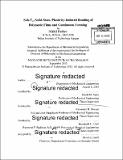| dc.contributor.advisor | David M. Parks, Alexander H. Slocum, and Bernhardt L. Trout. | en_US |
| dc.contributor.author | Padhye, Nikhil, Ph. D. Massachusetts Institute of Technology | en_US |
| dc.contributor.other | Massachusetts Institute of Technology. Department of Mechanical Engineering. | en_US |
| dc.date.accessioned | 2016-03-25T13:37:39Z | |
| dc.date.available | 2016-03-25T13:37:39Z | |
| dc.date.copyright | 2015 | en_US |
| dc.date.issued | 2015 | en_US |
| dc.identifier.uri | http://hdl.handle.net/1721.1/101816 | |
| dc.description | Thesis: Ph. D., Massachusetts Institute of Technology, Department of Mechanical Engineering, 2015. | en_US |
| dc.description | In title on title-page, double-underscored "g" appears as subscript. Cataloged from PDF version of thesis. | en_US |
| dc.description | Includes bibliographical references (pages 271-310). | en_US |
| dc.description.abstract | If two pieces of a glassy polymer are brought into intimate contact (within molecular proximity) at temperatures well below their glass transition temperature (Tg) negligible adhesion, due to lack of inter-diffusion of macromolecules, will be noted. Because polymer chains are kinetically trapped well below the Tg, the time-scales for relaxations in the glassy state are extremely large, and the system is effectively frozen with respect to any long range diffusive motion. This thesis shows the discovery of a new phenomenon of solid-state, plasticity-induced bonding at temperatures well below Tg which take on the order of a second, by subjecting amorphous polymers to active plastic deformation. In spite of the glassy regime, the bulk plastic deformation triggers requisite molecular mobility of polymer chains to cause inter-penetration across the interface. Quantitative levels of adhesion and morphology of the fractured interfaces validate the sub-Tg, plasticity-induced, molecular mobilization causing bonding. The absence of bonding during compression of films in a near hydrostatic setting (which inhibits plastic flow), and between an 'elastic' and a 'plastic' film, further establishes the explicit role of plastic deformation in this newly reported sub-Tg solid-state bonding. Other components of this thesis comprise the design and fabrication of machines to perform continuous forming and sub-Tg, solid-state bonding of polymer films. A peel-test fixture has also been designed and developed to improve the T-peel test for determination of mode-I fracture toughness of thin and flexible adhered laminates. This research has been conducted as a part of an ongoing activity at the Novartis-MIT Center for Continuous Manufacturing at MIT. | en_US |
| dc.description.statementofresponsibility | by Nikhil Padhye. | en_US |
| dc.format.extent | 310 pages | en_US |
| dc.language.iso | eng | en_US |
| dc.publisher | Massachusetts Institute of Technology | en_US |
| dc.rights | M.I.T. theses are protected by copyright. They may be viewed from this source for any purpose, but reproduction or distribution in any format is prohibited without written permission. See provided URL for inquiries about permission. | en_US |
| dc.rights.uri | http://dspace.mit.edu/handle/1721.1/7582 | en_US |
| dc.subject | Mechanical Engineering. | en_US |
| dc.title | Sub-Tg̳, solid-state, plasticity-induced bonding of polymeric films and continuous forming | en_US |
| dc.title.alternative | Sub-glass transition temperature, solid-state, plasticity-induced bonding of polymeric films and continuous forming | en_US |
| dc.type | Thesis | en_US |
| dc.description.degree | Ph. D. | en_US |
| dc.contributor.department | Massachusetts Institute of Technology. Department of Mechanical Engineering | |
| dc.identifier.oclc | 941280944 | en_US |
